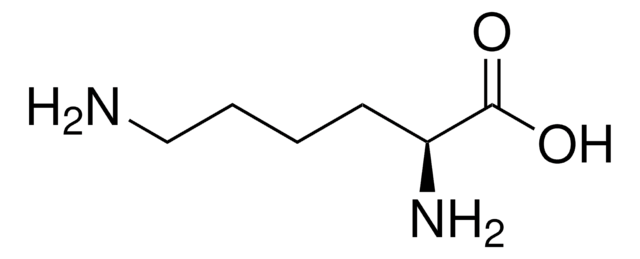1.04351
L-Histidine
for biochemistry
Synonym(s):
His, (S)-2-Amino-3-(4-imidazolyl)propionic acid, NSC 137773
About This Item
Recommended Products
Quality Level
form
solid
potency
>5110 mg/kg LD50, oral (Rat)
pH
7.7 (20 °C, 10 g/L in H2O)
mp
282 °C (dec.) (lit.)
solubility
38.2 g/L
bulk density
430 kg/m3
storage temp.
2-30°C
SMILES string
N[C@@H](Cc1c[nH]cn1)C(O)=O
InChI
1S/C6H9N3O2/c7-5(6(10)11)1-4-2-8-3-9-4/h2-3,5H,1,7H2,(H,8,9)(H,10,11)/t5-/m0/s1
InChI key
HNDVDQJCIGZPNO-YFKPBYRVSA-N
Looking for similar products? Visit Product Comparison Guide
Biochem/physiol Actions
Analysis Note
Identity (IR-spectrum): passes test
Appearance: white to almost white, fine-crystalline powder or colorless crystals
Appearance of solution (50 g/l; water): clear and colorless
Spec. rotation (α 20/D, 110 g/l, hydrochloric acid 120 g/l, calc. on dried substance): +11.4 to +12.4
Chloride (Cl): ≤ 200 ppm
Sulfate (SO₄): ≤ 200 ppm
Heavy metals (as Pb): ≤ 10 ppm
As (Arsenic): ≤ 5 ppm
Ca (Calcium): ≤ 10 ppm
Co (Cobalt): ≤ 5 ppm
Fe (Iron): ≤ 5 ppm
K (Potassium): ≤ 5 ppm
Mg (Magnesium): ≤ 5 ppm
Na (Sodium): ≤ 100 ppm
Zn (Zinc): ≤ 5 ppm
Ninhydrin-positive substances (LC)(any ninhydrin-positive impurity): ≤ 0.2 %
Ninhydrin-positive substances (LC) (ammonium (570 nm)): ≤ 0.02 %
Ninhydrin-positive substances (LC)(total impurities): ≤ 0.5 %
Loss on drying (105 °C; 3 h): ≤ 0.2 %
Storage Class Code
11 - Combustible Solids
WGK
WGK 1
Flash Point(F)
Not applicable
Flash Point(C)
Not applicable
Certificates of Analysis (COA)
Search for Certificates of Analysis (COA) by entering the products Lot/Batch Number. Lot and Batch Numbers can be found on a product’s label following the words ‘Lot’ or ‘Batch’.
Already Own This Product?
Find documentation for the products that you have recently purchased in the Document Library.
Customers Also Viewed
Our team of scientists has experience in all areas of research including Life Science, Material Science, Chemical Synthesis, Chromatography, Analytical and many others.
Contact Technical Service
